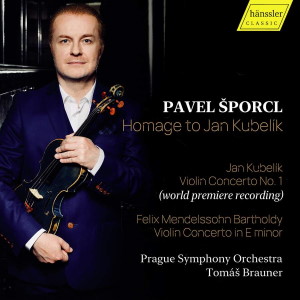
Hommage to Jan Kubelík
Jan Kubelík (1880-1940)
Violin Concerto No 1 in C major (1915-16)
Felix Mendelssohn (1809-1847)
Violin Concerto in E minor, Op 64 (1844)
Pavel Šporcl (violin)
Prague Symphony Orchestra/Tomáš Brauner
rec. 2022, Municipal House, Smetana Hall, Prague
HÄNSSLER HC22065 [63]
This is the first commercial recording of Jan Kubelík’s Violin Concerto No 1, made in Prague by one of the Czech Republic leading violinists – certainly its most charismatic and best-known internationally, Pavel Šporcl. I should add a brief addendum to this: Miroslav Vilímec, the then concertmaster of the Czech Philharmonic, recorded it with his pianist brother Vladislav in piano reduced form at a concert in the Suk Hall of the Rudolfinum to celebrate the 130th anniversary of Kubelík’s birth (Jan Kubelík Society SJK009). This historically valuable disc also has Kubelík himself performing the first movement of his Fourth Concerto and part of the second movement in the second half of the 1920s, again in piano reduction. I notice that in his acknowledgements, Šporcl specifically thanks Vilímec and the Kubelík Society
During the years 1915-20 Kubelík retired from public performance and turned to composition. He could have pursued a career nationally though international touring was, of course, largely impossible, especially to two of his major ports of call, Britain and America. He did emerge to premiere the First Concerto in Vienna in January 1917 with his compatriot Oskar Nebdal conducting. It’s going to be interesting to see if Šporcl records all six because the First is a generously expressive, romantic work cast in a standard three-movement form but it’s only the start of the Kubelík concerto journey.
Kubelík’s opening gambit in the First Concerto is a brassy fanfare figure followed by a solo cadenza, a procedure he repeats. He’d clearly absorbed lessons from concertos he had himself played but it’s interesting that this so-called Paganini redivivus should embrace lyricism somewhat at the expense of showy virtuosity in this first movement. Tully Potter is quite right to characterise the concerto as subtly varied in its thematic writing. I’d add that it’s also a touch operatic and Smetana-like in places, with plenty of aerial writing for the violin and structurally pertinent use of the percussion. The pirouetting deftness of the central movement is rhapsodically formulated and convincing. In the finale Kubelík unleashes high spirits, keeping the soloist busy with genial writing and some near-Oriental themes in the central panel. The violin rides, trill-laden, though with restful asides, into the athletic and forceful peroration.
This early example of Kubelik’s compositional prowess may not be quite the equal of the more complex, quirky work of a contemporary violinist-composer, such as Joan Manén (review) but it reveals the depth of his compositional attainment at a time when soloists were – and were expected to be – composers too.
When Kubelík and his accompanist appeared before Queen Victoria at Windsor Castle in July 1900 they played the second and third movements of Mendelssohn’s concerto. It was probably the last concert the Queen attended. So, it makes some kind of sense for Šporcl to perform it here, though I suspect it’s Hänssler’s insurance policy to attract listeners. Whether, however, it makes real commercial sense is, I think, another question. Anyway, I can only review what’s in front of me, not what I’d prefer to be in front of me – which is either Kubelík’s Fourth or Sixth Concertos. The sound is a touch swampy in the Municipal House but not enough to dampen the soloist’s unhackneyed responses. He plays with flair and sensitivity, employing slides, quite rightly, and strong dynamics – especially pp – and fortunately the solo violin is forward in the balance though not quite at the expense of proper balance. Changes of colour illuminate the slow movement and he phrases with consummate plasticity. His finale is attractive albeit not ebullient. This is a resilient, responsible performance which he doubtless played on that weird blue fiddle of his. The Prague Symphony Orchestra under Tomáš Brauner, here and in the companion concerto, offer wholehearted support.
If you are intrigued by the Kubelík, I think you’ll enjoy both it and the Mendelssohn, though not necessarily equally. Let’s hope, though, that more Kubelík is on its way from Šporcl.
Jonathan Woolf
Help us financially by purchasing through



















